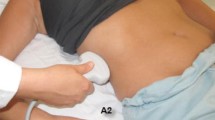Summary
Placement of a transvenous vena cava filter has became a common way to control recurrent pulmonary embolism. However few studies have been reported on the diameter of the infrarenal inferior vena cava (IIVC) where the device is usually placed. This study based upon 100 cavographies has showed the calculated average diameter of IIVC was 20.9 mm (range 12–27 mm) in its middle part and 21.3 mm (range 10–31 mm) in its terminal end. The calculated average IIVC length was 96 mm (range 80.3–142 mm). There was no statistical correlation between caval size and age, sex, height, weight and corporeal area. There was a statistical difference of left renal vein location between patients presenting with lumbar arthrosis and those without. We discuss different methods to measure IIVC in particular tomodensitometry. CT scans reviewed in our department show that the largest diameter of IIVC is not in a frontal plane and that the width seen on cavography is the projection of the largest diameter on the film. Therefore, the range of the real caval diameters is greater than indicated above.
Résumé
L'utilisation de filtre cave endoveineux pour prévenir une récidive d'embolie pulmonaire est devenue d'un usage courant. Cependant peu de travaux ont été faits sur le diamètre de la veine cave inférieure infrarénale (IIVC) où l'appareil est généralement situé. Cette étude a pour but d'étudier le diamètre transversal de la VCI sousrénale (VCISR) à partir de 100 cavographies réalisées dans des conditions techniques identiques. Le diamètre moyen de la VCISR est de 20.9 mm (extrême 12–27 mm) dans sa partie moyenne et de 21.3 mm (extrême 10–31 mm) au niveau de sa terminaison. La longueur moyenne de la VCISR est de 96 mm (extrême 80,3–142 mm). L'âge, le sexe, la taille, le poids, la surface corporelle n'influencent pas les dimensions de la VCISR. Il existe une différence statistiquement significative de l'abouchement de la v. rénale gauche entre les sujets ayant une arthrose lombaire et ceux qui en sont dépourvus.
La cavographie reste un examen de base en matière d'exploration de la VCI. La connaissance des variations des dimensions de la VCISR qu'elle apporte est donc indispensable. L'intérêt de cette étude est cependant limité par le fait que l'image radiologique correspond en réalité à la projection du diamètre transversal réel. Des études complémentaires utilisant en particulier la tomodensitométrie sont donc nécessaire pour préciser une éventuelle relation entre le diamètre réel et le diamètre mesuré par cavographie.
Similar content being viewed by others
References
Andreassian B, Cohen G, Duchatelle JP, Kitzis M, Chalaux G, Parot A, Richer De Forges M (1984) Méthodes, résultats et indications de l'interruption de la veine cave inférieure. Chirurgie 110: 472–480
Berland L, Maddison F, Bernhard U (1980) Radiologic follow-up of Vena cava filter devices. AJR 134: 1047–1052
Bonnichon Ph, Chapuis Y (1986) Quand et comment interrompre la veine cave inférieure. Gazette Med 93: 49–55
Bonnin A (1984) Lecture accélérée de l'échographie. Maloine, Paris
Chapuis Y, Bonnichon Ph, Zerbib M, Pinto Ph (1984) Interruption partielle du courant cave inférieur: clip ou ombrelle ? Chirurgie 110: 309–312
Cimochowski GE, Evans RH, Zarins CK, Lu C, De Meester TR (1980) Greenfield filter versus Mobin Uddin Umbrella. J Thorac Cardiovas Surg 79: 358–365
Dutta SK, Plotnick GD, Williams R, Morris F (1978) Massive dilatation of the inferior vena cava. JAMA 239: 135–136
Gillot C (1980) La veine cave inférieure infra-rénale. Anat Clin 2: 301–315
Goldhaber S, Buring JG, Lipinck RJ, Stubblefied F, Hennekens C (1984) Interruption of the inferior vena cava by clip or filter. Am J Med 76: 512–516
Gomez G, Cutler B, Wheeler HB (1983) Transvenous interruption of the inferior vena cava. Surgery 93: 612–619
Grant E, Rendano F, Sevinc E, Gammelgaard J, Holm H, Gronvall S (1980) Normal inferior vena cava: caliber changes observed by dynamic ultrasound. AJR 135: 335–338
Greenfield L, Zocco J, Wilk J, Schroeder TM, Elkins RC (1977) Clinical experience with Kim Ray Greenfield vena cava filter. Ann Surg 185: 692–698
Lemaire R (1982) L'écoulement du sang dans les veines. Sandoz, Rueil Malmaison
Mac Intyre AB, Mc Cready RA, Hyde GL, Mattingly W (1984) A ten year follow-up study of the Mobin Uddin filter of vena cava interruption. SGO 158: 513–516
Menzoian JO, Logerfo FW, Doyle JE, Weitpman AF, Sequeira JC (1981) Technical Modifications in the placement of inferior vena cava filter devices. Am J Surg 142: 216–218
Mobin Uddin K, Mc Lean R, Bolooki H, Jude JR, Gables C (1969) Caval interruption for prevention of pulmonary embolism. Arch Surg 99: 711–715
Mobin Uddin K, Utley JR, Bryant L (1975) The inferior vena cava umbrella filter. Prog Cardiovasc Dis 17: 391–399
Office Régional de la Santé: Dossiers du COREDIF. Eléments de références sur la situation démographique en Ile de France, janvier 1984. IAURIF, 21–23, rue Miollis, 75732 Paris Cedex 15
Orval TO, Gallard GM, Jude JR (1973) Prevention of pulmonary embolus with vena cava umbrella. Ann Thorac Surg 15: 196–201
Philips MR, Widrich WC, Johnson WC (1980) Perforation of the inferior vena cava by Kim Ray Greenfield filter. Surgery 87: 233–235
Prince MR, Novelline RA, Athansoulis CA, Simon M (1983) The diameter of the inferior vena cava and its implications for the use of vena cava filters. Radiology 149: 687–689
Riggs OE (1972) Vena cavography relative to umbrella filter placement. Radiology 105: 450–451
Taboury J (1982) Guide pratique d'échographie abdominale. Masson, Paris
Author information
Authors and Affiliations
Rights and permissions
About this article
Cite this article
Bonnichon, P., Gaudard, F., Ouakil, E. et al. Biometry of infrarenal inferior vena cava measured by cavography. Surg Radiol Anat 11, 149–154 (1989). https://doi.org/10.1007/BF02096473
Received:
Revised:
Accepted:
Issue Date:
DOI: https://doi.org/10.1007/BF02096473




